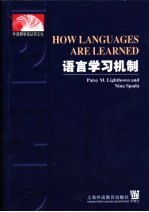图书介绍
语言学习机制 英文本PDF|Epub|txt|kindle电子书版本下载

- (加)PatsyM.Lightbown,(加)NinaSpada著 著
- 出版社: 上海:上海外语教育出版社
- ISBN:7810806114
- 出版时间:2002
- 标注页数:192页
- 文件大小:8MB
- 文件页数:208页
- 主题词:外语教学(学科: 教学法) 外语教学 教学法
PDF下载
下载说明
语言学习机制 英文本PDF格式电子书版下载
下载的文件为RAR压缩包。需要使用解压软件进行解压得到PDF格式图书。建议使用BT下载工具Free Download Manager进行下载,简称FDM(免费,没有广告,支持多平台)。本站资源全部打包为BT种子。所以需要使用专业的BT下载软件进行下载。如BitComet qBittorrent uTorrent等BT下载工具。迅雷目前由于本站不是热门资源。不推荐使用!后期资源热门了。安装了迅雷也可以迅雷进行下载!
(文件页数 要大于 标注页数,上中下等多册电子书除外)
注意:本站所有压缩包均有解压码: 点击下载压缩包解压工具
图书目录
1 Learning a first language1
Milestones and patterns in development1
Early childhood bilingualism3
Developmental sequences4
Summary9
Theoretical approaches to explaining first language learning9
Behaviourism:Say what I say9
Activity: Analysing children’s speech10
Innatism: It’s all in your mind15
The interactionist position: A little help from my friends22
Summary25
2 Theoretical approaches to explaining second language learning31
Activity: Learner profiles32
Behaviourism35
Innatism36
Universal Grammar36
Krashen’s ‘monitor model’38
Recent psychological theories41
Information processing41
The interactionist position42
Connectionism42
Summary45
3 Factors affecting second language learning49
Activity: Characteristics of the‘good language learner’49
Research on learner characteristics51
Intelligence52
Aptitude53
Personality54
Motivation and attitudes56
Learner preferences58
Learner beliefs59
Age of acquisition60
Activity: Comparing child, adolescent, and adult language learners66
Summary68
4 Learner language71
The concept of learner language72
Activity: The Great Toy Robbery74
Developmental sequences76
Grammatical morphemes76
Negation77
Questions78
Activity: More about questions80
Activity: Learners’questions80
Relative clauses83
Reference to past84
Movement through developmental sequences85
New ways of looking at first language influence85
Summary87
5 Observing second language teaching91
Comparing instructional and natural settings for language learning91
Activity: Natural and instructional settings91
Activity: Classroom comparisons: teacher-student interactions96
Classroom observation schemes101
Activity: Observing the kinds of questions you ask your students102
Feedback in the classroom103
Activity: Analysing classroom interaction106
Summary of transcripts113
Activity: Observing how you respond to students’errors113
Summary115
6 Second language learning in the classroom117
Five proposals for classroom teaching117
1 Get it right from the beginning118
2 Say what you mean and mean what you say122
3 Just listen…and read128
4 Teach what is teachable135
5 Get it right in the end141
The implications of classroom research for teaching149
Summary152
7 Popular ideas about language learning: Facts and opinions161
1 Languages are learned mainly through imitation161
2 Parents usually correct young children when they make grammatical errors162
3 People with high IQs are good language learners163
4 The most important factor in second language acquisition success is motivation163
5 The earlier a second language is introduced in school programs, the greater the likelihood of success164
7 Teachers should present grammatical rules one at a time165
6 Most of the mistakes which second language learners make are due to interference from their first language165
8 Teachers should teach simple structures before complex ones166
9 Learners’errors should be corrected as soon as they are made in order to prevent bad habits167
10 Teachers should use materials that expose students only to language structures they have already been taught168
11 When learners are allowed to interact freely they learn each others’mistakes168
12 Students learn what they are taught169
Conclusion169
Glossary171
Bibliography180
Index190